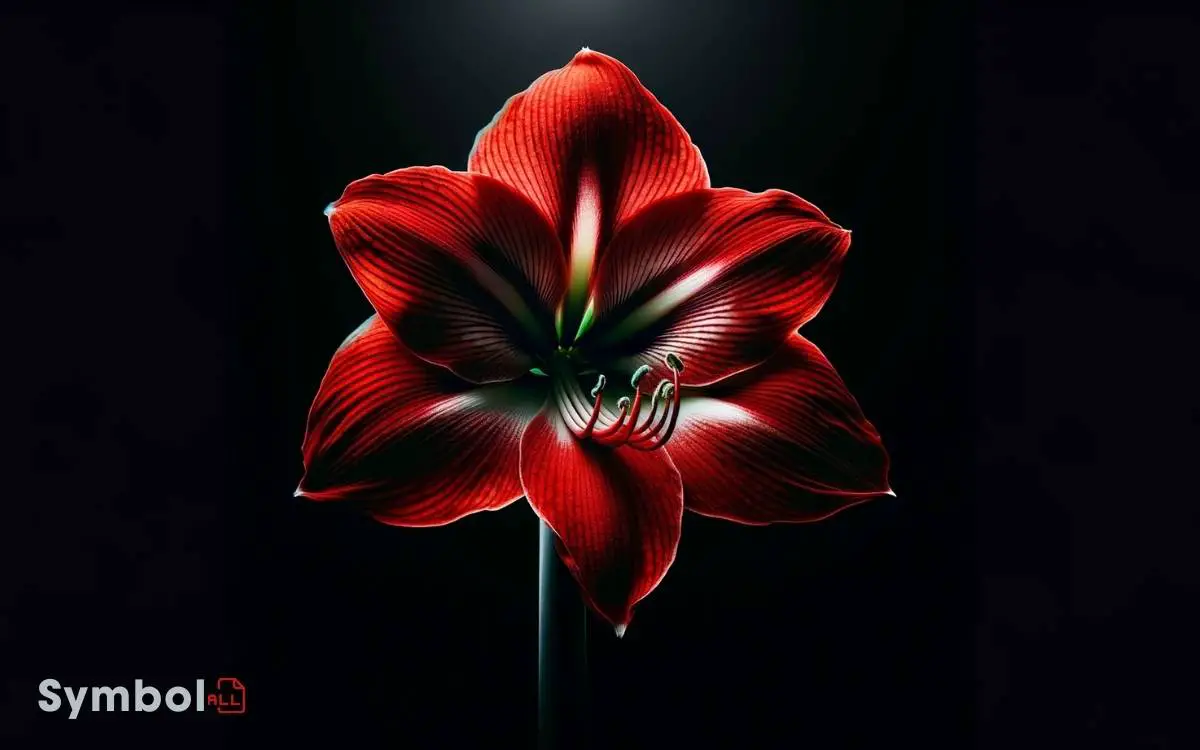What Does the Amaryllis Flower Symbolize? Deep Love!
The Amaryllis, belonging to the family Amaryllidaceae and genus Hippeastrum, carries significant symbolism woven into human culture. In Greek mythology, it represents deep love and sacrifice, reflecting themes of beauty and personal achievement.
Its resilience, showcased through adaptations like nutrient storage in its bulb and protective petals, symbolizes strength and the ability to thrive under adversity.
This flower’s diverse colors ranging from vibrant reds symbolizing passion, to pure whites indicating innocence add layers to its meaning, encompassing love, pride, and determination.
Each hue and shape speaks to its diverse symbolism, enriching gift-giving traditions and celebrations. Exploring this flower’s story further reveals a deeper connection to its historical roots and cultural impact.

Key Takeaways
Historical Significance
Throughout history, the Amaryllis flower has held significant symbolic meaning, deeply rooted in various cultures and mythologies, embodying themes of pride, splendid beauty, and determination.
Scientifically classified under the genus Amaryllis, this enchanting plant belongs to the Amaryllidaceae family. Its taxonomy underscores a diversity that spans various species, each characterized by unique floral attributes.
Traditionally, its striking appearance, with trumpet-shaped flowers and bold colors, has been interpreted as a marker of beauty and personal achievement.
In Greek mythology, Amaryllis symbolizes the blood of the nymph Amaryllis, who pierced her heart to catch the attention of her unrequited love, demonstrating the flower’s association with deep love and sacrifice.
This historical context provides a rich tapestry of meanings, enriching your understanding of this botanical marvel.
Symbol of Strength
Building on its historical significance, the Amaryllis also embodies a powerful symbol of strength, a confirmation of its resilient nature and robust growth patterns observed across different species within the Amaryllidaceae family.
This resilience isn’t merely anecdotal but is underpinned by specific adaptations and characteristics intrinsic to the genus.
For instance, the bulb of the Amaryllis, an essential organ for its survival, allows it to store nutrients and water, enabling it to withstand periods of drought and adverse conditions.
Furthermore, its thick, waxy petals aren’t just aesthetically pleasing but serve as a protective barrier, safeguarding the reproductive organs from harm.
The Amaryllis’s ability to bloom even in less than ideal conditions is a confirmation of its inherent strength, making it a poignant emblem for endurance and vitality.
Representation of Determination
You observe the Amaryllis (genus Amaryllis) navigate through harsh conditions, embodying growth through adversity. Its bulb, buried in nutrient-scarce soil, mobilizes inner strength to burgeon a resilient stalk and vibrant blooms.
This process mirrors resilience in bloom, showcasing an unwavering determination to thrive.
Growth Through Adversity
Many cultures regard the amaryllis flower as a symbol of determination, representing growth through adversity with its ability to bloom in less-than-ideal conditions.
Belonging to the genus Amaryllis, this resilient plant showcases its robust nature by thriving in environments where lesser species might falter. Its bulb, a storehouse of nutrients, enables the plant to endure periods of scarcity.
As you observe an amaryllis pushing its vibrant petals through the soil, you’re witnessing a live demonstration of perseverance. This botanical phenomenon doesn’t just survive; it prospers, offering a vivid display of the power of enduring challenges.
This emblem of resilience serves as a botanical metaphor for pushing through obstacles, embodying the essence of thriving despite adversity.
Inner Strength Blossoming
The amaryllis flower embodies inner strength, its bloom serving as a symbol of unwavering determination in the face of challenges.
Originating from the Amaryllidaceae family, this plant’s ability to thrive under adverse conditions and still produce vibrant flowers is a sign of its resilience.
When you observe the amaryllis, consider the following aspects:
- Botanical Adaptability: Its bulb can store nutrients, allowing it to survive in less than ideal conditions.
- Growth Cycle: The amaryllis progresses from a dormant state to full bloom, mirroring the journey of overcoming obstacles.
- Symbolic Representation: Each layer of its petals can be seen as a layer of strength, revealing more as it unfolds.
Understanding the amaryllis’s characteristics encourages a deeper appreciation for its representation of determination.
Resilience in Bloom
Building on the inner strength the amaryllis symbolizes, its resilience in bloom further exemplifies determination, showcasing how this plant not only survives but thrives under challenging conditions.
Belonging to the Amaryllidaceae family, the genus Amaryllis stands out for its ability to endure and adapt to various environments. This characteristic mirrors the human capacity for resilience in the face of adversity.
The bulb of an amaryllis stores essential nutrients, enabling it to enter a dormant state and later rebloom with vigor, even in less-than-ideal conditions. This cycle of rebirth and resilience serves as a powerful analogy for personal growth and perseverance.
You’ll observe that each bloom, with its striking colors and robust form, is a reflection of the tireless spirit embodied within.
Love and Attraction
Amaryllis flowers symbolize deep love and attraction, making them a poignant choice for expressing romantic feelings.
Originating from the genus Amaryllis, these flowers have a striking appearance that catches the eye, acting as a powerful symbol for the intensity of romantic emotions.
- Vibrant Colors: The deep reds and pinks are often associated with passion and love, making them ideal for romantic gestures.
- Bold Shapes: The large, trumpet-shaped blooms represent a bold declaration of love and attraction.
- Seasonal Blooming: Blooming in winter, amaryllis symbolizes the ability to bring warmth and brightness to a loved one’s life during the colder months.
Understanding the symbolism behind these flowers can add layers of meaning to your gesture of affection, reflecting the depth of your feelings in a way words alone can’t convey.
Pride and Vanity
As you explore the Amaryllis genus, specifically its bold and striking blooms, you encounter themes of pride and vanity reflected in various cultures’ interpretations.
These flowers, with their large, trumpet-shaped blossoms, serve as a botanical symbol for both qualities, mirroring personal reflections on self-esteem and self-admiration.
The taxonomy of Amaryllis emphasizes its distinctiveness, further aligning with the notions of pride in one’s unique beauty and the potential for vanity that such uniqueness can foster.
Cultural Interpretations
Throughout various cultures, the amaryllis flower symbolizes both pride and vanity, reflecting its striking appearance and the way it stands tall and commands attention in any setting.
Belonging to the genus Amaryllis, this bloom isn’t just a feast for the eyes; it carries deep symbolic weight across different societies.
- In Greek mythology, Amaryllis’s vibrant red petals are associated with the blood of Amaryllis, symbolizing a strong will and determination.
- Victorian England saw the amaryllis as a beacon of pride, given to those who achieved success with their head held high.
- In Chinese culture, the amaryllis represents wealth and fortune, admired for its ability to bloom splendidly without much fuss.
Understanding these cultural interpretations allows you to appreciate the amaryllis beyond its visual appeal, recognizing its rich symbolic history.
Personal Reflections
Reflecting on the pride and vanity symbolized by the amaryllis requires examining its botanical uniqueness and the way its characteristics have shaped human perceptions.
Its striking appearance and the manner in which it commands attention in any setting mirror traits often associated with pride and vanity in humans.
You’re drawn to its vibrant colors and imposing stature, much like how one is drawn to individuals exuding confidence and self-assurance.
| Trait | Reflection |
|---|---|
| Vibrant Colors | Attractiveness & Confidence |
| Imposing Stature | Dominance & Self-assurance |
| Botanical Uniqueness | Individuality & Distinction |
| Growth Pattern | Ambition & Persistence |
| Seasonal Bloom | Timed Display of Beauty |
These parallels between the amaryllis and human emotions serve as a reminder of the complex interplay between nature and human psychology.
Amaryllis in Mythology
The amaryllis flower, deeply rooted in Greek mythology, symbolizes the enduring love and determination of a nymph named Amaryllis who sought the affection of a shepherd.
This enchanting tale not only highlights the flower’s beauty but also its significance in ancient narratives.
To keep you engaged, consider these facts:
- Amaryllis genus encompasses various species, each with unique characteristics and adaptations.
- The vivid red of the flower’s petals is often linked to the blood of Amaryllis from the myth.
- Botanically, amaryllis belongs to the family Amaryllidaceae showcasing its classification and evolution within plant taxonomy.
Understanding the amaryllis through the lens of mythology enriches your appreciation of its place in both nature and culture, demonstrating the intricate relationship between flora and storytelling.
Friendship and Social Bonds
In exploring the symbolism of the amaryllis flower, it’s fascinating to discover its representation of friendship and social bonds within various cultures.
Belonging to the genus Amaryllis, this flower stands out with its vibrant blooms, which are often seen as emblems of social harmony and mutual respect.
The structure of the Amaryllis, characterized by its sturdy stem that supports multiple striking flowers, symbolizes the strength and support found in friendships.
Its growth process, from a dormant bulb to a flourishing plant, mirrors the development and deepening of social connections over time.
Culturally, giving an amaryllis is akin to expressing appreciation for the recipient’s presence in one’s life, highlighting the plant’s role in celebrating and nurturing relationships beyond mere acquaintance.
Success and Achievement
In the domain of Amaryllidaceae, particularly the genus Amaryllis, the blossoms symbolize not only beauty but also the notion of success and accomplishment.
You’ll notice that these flowers, with their vibrant colors and strong growth, embody victory in pursuits and the acknowledgment of quality.
They act as a botanical analogy for chasing personal goals, reflecting the plant’s own journey from bulb to striking bloom.
Triumph in Endeavors
Often, the amaryllis flower symbolizes success and achievement, reflecting an individual’s triumph in various endeavors through its vibrant blooms. This symbolism isn’t arbitrary; it’s deeply rooted in the plant’s biological resilience and striking features.
- Rapid Growth Cycle: Amaryllis bulbs can bloom within 7-10 weeks after planting, a confirmation of quick success and the fulfillment of goals.
- Vibrant Colors: The flower’s vivid hues, ranging from deep reds to bright whites, signify the celebration of achievements.
- Perennial Nature: As a perennial, the amaryllis returns year after year, symbolizing enduring success and the ability to overcome obstacles.
Understanding these aspects allows you to appreciate the deeper meaning behind the amaryllis’ representation of triumph in endeavors, beyond its superficial beauty.
Recognition of Excellence
The amaryllis flower stands as a beacon of excellence, symbolizing not only success but also the high recognition of achievements in various fields.
Belonging to the genus Amaryllis, this bloom is renowned for its striking, bold colors and large, trumpet-shaped flowers, which serve as a metaphor for announcing one’s accomplishments with pride.
In the domain of plant taxonomy, Amaryllis spp. is distinguished by its solitary, sturdy stem which supports the weight of the bloom, akin to how an individual upholds their achievements.
Through its robust growth and blooming cycle, the amaryllis exemplifies resilience and the culmination of hard work, mirroring the journey to professional acclaim and the celebration of milestones in one’s career.
Pursuing Personal Goals
Embodying the essence of determination, amaryllis flowers bloom with a resilience that mirrors your journey toward achieving personal goals.
These striking plants, belonging to the genus Amaryllis, are more than just aesthetically pleasing; they’re a symbol of the hard work and perseverance required to succeed.
- Sturdiness: Just as the amaryllis withstands various environments to bloom, you’re capable of overcoming obstacles.
- Growth: The bulb of the amaryllis symbolizes potential, reminding you that success starts with a small step.
- Beauty: Achieving your goals, much like the flower reaching full bloom, results in a beautiful display of your capabilities.
Understanding the amaryllis’ life cycle, from bulb to bloom, parallels the journey of setting, pursuing, and achieving personal goals, highlighting nature’s profound connection to human aspirations.
Beauty and Grace
Amaryllis flowers enchant onlookers with their striking beauty and graceful appearance, symbolizing both strength and delicate charm in the world of botany.
Belonging to the genus Amaryllis, these flowers exhibit a range of vibrant colors, from the deepest reds to the purest whites, each hue contributing to their overall allure.
The structure of an Amaryllis flower is a marvel of natural design. Its long, slender stem supports a bold, trumpet-shaped bloom, which stands out in stark contrast to the more diminutive flowers in a garden.
This architectural elegance, combined with the plant’s robust growth habits, illustrates the dual nature of beauty and grace.
You’ll find that Amaryllis embodies a perfect harmony: its enchanting form is a reflection of the intricate complexity and simplicity found in nature.
Healing and Recovery
In the domain of healing and recovery, the Amaryllis flower, or Amaryllis belladonna, stands out for its significant impact.
You’ll find its vibrant blooms not only symbolize emotional renewal but also represent physical strengthening.
This botanical marvel underscores the resilience inherent in nature and in oneself, bridging the gap between aesthetic beauty and therapeutic potency.
Emotional Renewal Significance
Often, the amaryllis flower symbolizes emotional renewal and recovery, offering hope to those steering the challenging journey of healing.
This bulbous plant, belonging to the Amaryllidaceae family, emerges as a beacon of resilience and transformation, its vibrant blooms representing the light at the end of a dark tunnel for many.
To understand its significance in emotional healing, consider the following:
- Resilience: The amaryllis pushes through the soil with determination, mirroring the inner strength required for emotional recovery.
- Growth: Its lifecycle, from bulb to bloom, symbolizes personal development and renewal.
- Brightness: The striking colors of the amaryllis flowers are often associated with positivity, uplifting spirits during difficult times.
Embracing the amaryllis’s symbolism can inspire a sense of hope and encouragement in the face of emotional adversity.
Physical Strengthening Representation
Beyond its emotional symbolism, the amaryllis flower also represents the journey of physical healing and recovery, highlighting the body’s capacity to regenerate and strengthen.
In the world of plant taxonomy, the amaryllis, or Amaryllis belladonna, showcases robustness through its bulbous structure, which stores nutrients required for its growth and resilience.
This attribute mirrors the human body’s ability to heal and recover, drawing parallels between botanical vigor and physical health.
| Amaryllis Aspect | Human Parallel |
|---|---|
| Bulbous Structure | Body’s Resilience |
| Nutrient Storage | Healing Resources |
| Growth and Bloom | Recovery Process |
Understanding this symbolism can inspire you to appreciate the natural resilience and healing capabilities inherent in both flora and the human body.
Amaryllis Color Meanings
The diverse hues of Amaryllis flowers, ranging from vibrant reds to delicate pinks, convey distinct symbolic meanings rooted in plant taxonomy and cultural interpretations. These colors aren’t just appealing to the eye; they’re steeped in significance.
- Red Amaryllis: Often symbolizing strong emotions and passion, the red Amaryllis is a bold declaration of love. Its deep color is tied to the vitality and courage found within.
- White Amaryllis: This color represents purity, innocence, and peace. It’s a symbol of unblemished beauty and is often associated with new beginnings and clarity of thought.
- Pink Amaryllis: Signifies affection and admiration. The softer hue suggests a gentler emotion, embodying grace and an invitation to convey warmth and friendship.
Each color embodies a unique message, allowing you to express specific sentiments through the language of flowers.
Amaryllis in Celebrations
Amaryllis flowers, known for their striking beauty and diverse color palette, play a pivotal role in various celebrations, symbolizing joy and festivity.
Belonging to the genus Amaryllis, these flowers exhibit a wide range of colors, from vivid reds to soft whites, each carrying its unique symbolism.
During celebratory events, the selection of Amaryllis often reflects the theme or emotional tone of the occasion.
For instance, their bulbous structure and vibrant blooms are integral to floral arrangements for winter holidays, symbolizing the anticipation of spring and renewal.
Additionally, in botanical terms, Amaryllis spp. are appreciated for their long-lasting flowers, making them ideal for decorations that require durability throughout the celebration.
Their presence enhances the aesthetic appeal and conveys a message of warmth and welcoming to guests.
Gift-Giving Traditions
While amaryllis flowers serve as key elements in celebrations, they also hold significant value in gift-giving traditions, symbolizing deep affection and admiration. Belonging to the genus Hippeastrum, these perennials aren’t just visually striking but carry profound meanings.
- Strength and Determination: The robust stalks and vibrant blooms represent resilience and the ability to overcome challenges.
- Pride and Enchanting Beauty: Gifting an amaryllis can convey a message of pride in someone’s accomplishments or admiration for their beauty.
- Achievement and Success: The flower’s association with victorious athletes in ancient Greece symbolizes reaching one’s goals.
Understanding these symbols allows you to choose amaryllis as a gift that communicates specific sentiments, making the act of giving even more meaningful.
The Amaryllis Today
Today, countless gardeners and horticulturists cultivate Hippeastrum species, widely known as amaryllis, for their spectacular blooms and diverse color variations.
These bulbous plants belong to the Amaryllidaceae family and have become synonymous with vibrancy and resilience in the plant kingdom.
The genus Hippeastrum comprises over 90 species and more than 600 hybrids, offering a wide spectrum of colors, from the deepest reds to the purest whites, and patterns that captivate the eye.
Each bulb produces multiple strappy leaves and hollow, sturdy stalks that support the trumpet-shaped flowers.
You’ll find that these perennials thrive in warm climates but can also be forced to bloom indoors during colder months, making them a versatile choice for year-round color and beauty in your home or garden.
Conclusion
In the tapestry of flora, the Amaryllis stands out as a beacon of resilience and passion, mirroring the human spirit’s own journey.
With petals that whisper tales of strength, determination, and the complexities of love, this flower embodies the dual essence of beauty and pride.
As Amaryllis belladonna navigates through seasons, its vibrant hues serve as a proof of nature’s intricate design, offering a kaleidoscope of meanings in the world of human emotions and celebrations, forever entwined in the dance of life.





